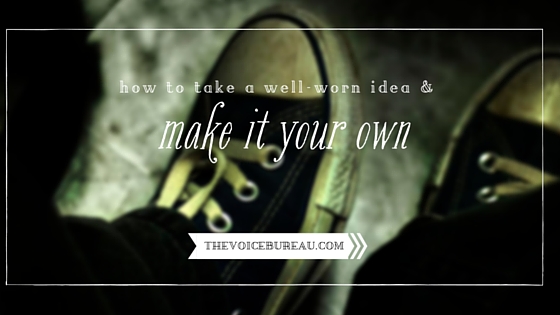About this column
Crafting craveable content brings your Right People to your doorstep. Maintaining a consistent content plan keeps them coming back for more. Need some help planning? Our ideas can help you get started, scheduled, and sharing.
Fact: we, as human beings, are inspired by one another.
We almost effortlessly push off of one another’s ideas, as we learn to articulate our own perspectives. We read a great book and have an inspiration — ding! — for our own great book. We gaze at a photograph or a work of art and we feel the stirrings of something altogether new in us.
It’s not wrong to tap into inspiration from elsewhere in order to fashion your own point of view. After all, theme-and-variations can be found throughout great art, literature, and music. (I wrote here about my own coming-to-terms with uniqueness — and accepting inspiration from elsewhere.)
But as brand creators and business owners making content for the interwebs, where’s the line between having your own iteration of a well-worn idea, and straight up parroting what someone else has done or said before you?
Where does inspiration become mimicry? Where does vibing off of someone’s idea, and then writing about it from our own point of view, become copycatting?
Keeping one’s own brand conversation well-defined and unique is a major concern of most of The Voice Bureau’s clients — and rightly so.
So how do you go about taking a well-worn idea — either a concept piloted by someone else or just a well-known concept that is ‘out there’ and begging you to put your unique spin on it — and make it your own?
Here are 3 questions you can ask yourself to help you hone in on your own point of view on a well-worn idea:
1. How did [the idea originator] get it wrong? In other words, what are you clarifying/putting to rest/setting straight?
2. What did [the idea originator] miss? What was overlooked? What didn’t they say?
3. What’s the ONE thing your Right People really need to hear/know/do/understand to make this idea work for them?
It’s true what they say: there’s nothing new under the sun. But there’s always a way a thoughtful and empathic brand creator can start with a well-worn idea and make it her own. Finding that point of differentiation is all about asking good questions.
In the comments, I want to know:
How have you made a well-worn idea your own? I’d love to hear about your process.

 Hello, you.
Hello, you.
{ 9 comments… read them below or add one }
I lay out my process here: http://pjrvs.com/theft/
Which got me a ton of hate-mail, but also a ton of “That makes sense!”.
LOVE your take, Paul, and I missed this post the first time around.
So glad you said this:
This way you don’t have to worry about being inspired or finding a muse at the start. Your muse is other work and other work is abundant. That way you only have to worry about adding your story and flavour to something existing, instead of starting with a blank slate.
This also reminds me of Austin Kleon’s Steal Like An Artist: http://austinkleon.com/2011/03/30/how-to-steal-like-an-artist-and-9-other-things-nobody-told-me/
Not only love this, Paul, but I think any other view than one along these lines is based in selfishness and arrogance. I can only hope that one day others will think my work worth taking improving, iterating, and repeating.
Abby it is asking those very kinds of questions that moved me away from other paradigms and to my own. My work has strong elements of philosophy, psychology, counseling, theology, and coaching, but it is not exactly any of these things because of what I believe these paradigms either do wrong, or leave out when considered alone. Voila. Me.
There ya go!
Yes!
I teach business courses to Chilean students, which often means translating what seem to be well-worn entrepreneurship ideas (at least among a certain buzzword-loving community: Lean Startup, Customer Development, Business Model Canvas, etc.) into something my students can understand. While I always mention the original source, I’ve found that the most effective classes are ones in which I choose a really concrete and dramatic example to illustrate the concept. My students especially connected with stories about my brother’s electric skateboard company and how Bespoke Innovations, a company that makes custom prosthetic legs, listened to its customers and used these insights to build a more sustainable business.
As I build my own brand, I’m continuing to use this crossover storytelling approach. I’m particularly drawn to theories of creativity and Business Model You, and I’m in the process of combining these topics with global career advising and entrepreneurship education.
I think your third question is especially powerful: What do your Right People need to make this idea work for them? In the case of my Right People, this means concrete examples that they can relate to.
Yes! I like this:
While I always mention the original source, I’ve found that the most effective classes are ones in which I choose a really concrete and dramatic example to illustrate the concept.
For many of us, we remember (and understand how to apply) a well-told story so much better than we do with a theory or a framework. Love that you’ve embraced your ability to move people into the concrete!
I freaking love that you took this on.
I feel as though, as Paul said, everything I learned was by watching others. I didn’t know how to blog so I read blogs. I watched how people used photography in their writing. I studied how people ran ecourses.
And then I would put in my own spin, voice and creations, always somewhat of a compilation of inspiration. If I told you my inspirations for each project I do you would say, Whoa, I don’t get that at all. Because you shouldn’t see the inspiration inside of it. But oh, it is always there. A story board full of it.
I see people mimic things I do all the time and I know that they just haven’t yet figured out how to take the inspiration and turn it into theirs. The best work we do will be highly inspired but so ours that it is ours through and through.
If it is true that there are no new ideas then we are just tasked with using huge amounts of creativity to own what we do and what we create.
xoxo
There is so much grace in this statement:
I see people mimic things I do all the time and I know that they just haven’t yet figured out how to take the inspiration and turn it into theirs. The best work we do will be highly inspired but so ours that it is ours through and through.
I know this is the truth, and yet, I find it hard to embrace sometimes! Thanks for modelling that openhandedness, Hannah.
I write and what I love about that medium is the limitless ways to convey oft-expressed concepts. My work isn’t correction—revision of a previous version’s error through clarification, amendment, adjustment, or undo and redo—but a new iteration served through a fresh spin of the kaleidoscope.
We now know that people learn and communicate in many different ways. A story told a hundred ways can land on someone’s heart or mind for the first time on the one-hundred and first telling. That is the beauty of art. And, as long as someone isn’t systematically replicating my content or duplicating it in copyright infringement ways, it means I’ve inspired a person to create something. That’s success, for me.